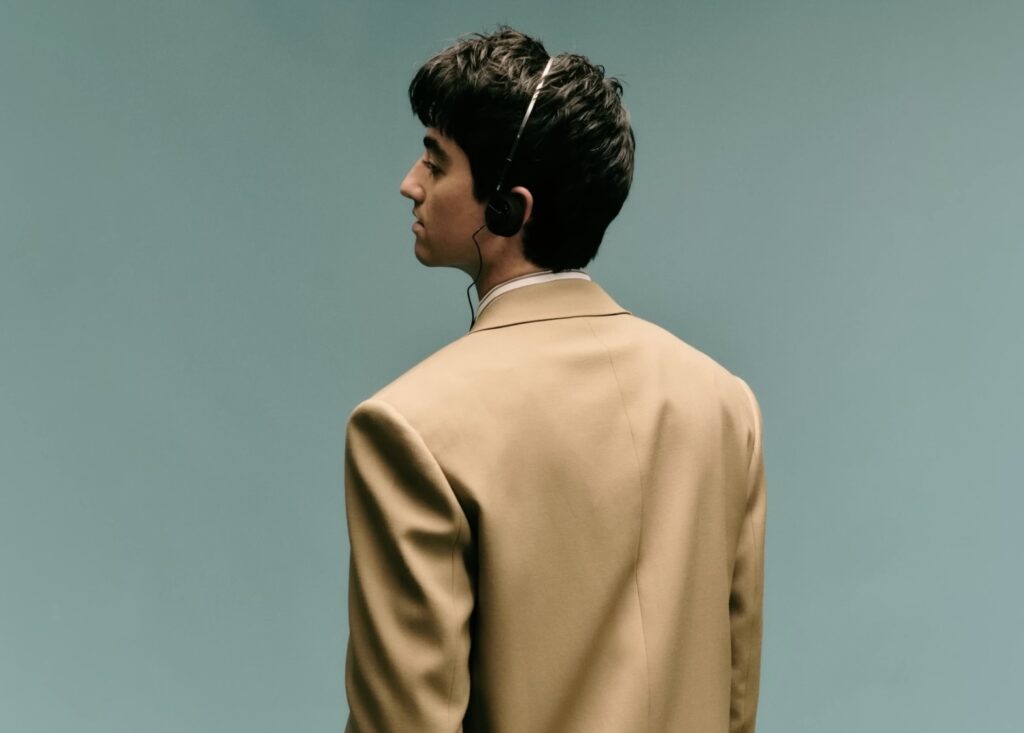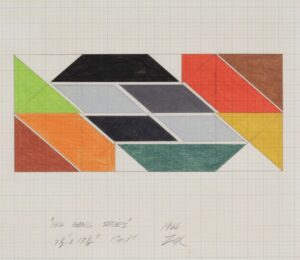There are certain artists who thrive in the fault lines—the spaces where pain meets melody, where chaos becomes charm. Woods has been steadily making a name for himself in this liminal space, and with his latest single, “Ghost on the Radio,” he leans into it fully. The song, haunted yet propulsive, is both a confession and an anthem. At its midst within sentiment lies the idea of heartbreak as something spectral, a voice that lingers in transmission long after the relationship has cut to silence.
Hooked on Haunting
“I wanted it to feel like you’re driving late at night and flipping stations, and suddenly you hear her voice,” Woods explains, sipping from a can of seltzer. “You know it’s not real, but it jolts you. That’s heartbreak—it creeps back in ways you don’t expect.”
The single embodies this sensation. Built around shimmering synth layers, punctuated by guitar lines that sound both bright and broken, “Ghost on the Radio” plays like a séance with memory. Lyrically, Woods pulls no punches: the imagery is visceral, the repetition deliberate. “I didn’t want metaphors to hide behind this time,” he says. “I wanted it raw—like a voicemail you shouldn’t still have saved.”
The Songwriting Smell Test
When asked what his songwriting process would smell like, Woods doesn’t hesitate:
“Burnt toast,” he laughs. “Because half the time I’m distracted. But also, there’s something comforting about it—familiar, a little nostalgic, but tinged with the sense that you’ve messed something up. That’s how writing feels. I’m chasing comfort, but I keep burning it at the edges.”
It’s an answer that encapsulates his creative style: warm but restless, grounded but never without a flicker of tension.
Era Talk: Between Consoles and Confessions
One of the threads that runs through our conversation is the language of “eras.” Woods speaks about his work in the same way gamers talk about consoles.
“My first EP? That was the Nintendo 64 era,” he says with a grin. “Big, colorful, maybe a little clunky, but it shaped how I see everything now. The last record was more PS2—sleeker, a little moodier. ‘Ghost on the Radio’ is like GameCube: weird, compact, surprisingly powerful for its size. People forget how many gems came out of that era.”
The metaphor is more than just coltish—it shows how Woods frames creativity as evolution. Each era comes with new mechanics, new risks, new textures. His fans aren’t just watching his career unfold; they’re conjuring through levels with him.
The Fashion of Fungus
Touring is exhausting, Woods admits, but also fertile ground for invention. One of his latest obsessions is sustainable fashion—particularly garments made from mycelium, the root system of fungi.
“It’s wild to think your tour hoodie could be grown in a lab,” he says. “Like, imagine merch that’s literally alive at one point. It’s recycling, fashion, and sci-fi all at once. If heartbreak is the ghost, maybe fungus is the future.”
This fascination isn’t just surface-level. Woods has been in talks with eco-designers to pilot fungal leather jackets for his upcoming tour. Either or not it will happen remains to be seen, but the idea underscores his ethos: reinvent, reimagine, recycle not just sound, but identity.
Ghosts in the Machine
Listening to Woods describe his music, one can’t help but notice how technology and hauntology intertwine. He cites Mark Fisher’s writings on cultural ghosts, the way the past refuses to stay past, as an inspiration.
“A song is basically a ghost anyway,” Woods muses. “You trap a moment in time, but every time it plays, it’s haunting you again. That’s why the radio metaphor made sense. It’s static and presence. It’s absence too.”
He references late nights playing Silent Hill 2 and how its radio static mechanic—buzzing louder as monsters approach—directly influenced the texture of the single. “The monster is memory,” he smiles.
Building Worlds, Not Singles
Woods insists that each single is more than a song; it’s a doorway. His upcoming record will expand on the spectral themes of “Ghost on the Radio,” weaving together a narrative about memory, media, and emotional hauntings.
“I want people to feel like they’re in a liminal arcade,” he says. “Like you’re walking past screens that flicker with old love letters, old conversations, games you never finished. That’s the record—unfinished levels, ghosts you can’t delete.”
Chaos into Charm
What makes Woods compelling is not just his sound, but his ability to alchemize chaos into charm. He doesn’t hide his tangents, his distractions, his obsessions with fungi or forgotten consoles. Instead, he folds them into his mythology.
“I’ve never wanted to be polished,” he admits. “I want to be like those scratched discs you had to blow on just to play. Messy but worth it. The chaos is part of the music.”
And somehow, it works. Fans don’t just hear songs; they feel invited into a world where heartbreak is a ghost, hooks are weapons, and chaos is strangely comforting.
Impression
As “Ghost on the Radio” readies itself to haunt playlists, Woods is already looking forward. There are plans for a concept tour, where each venue’s stage will be designed like a different “level” of a video game. There are conversations with fashion houses about fungal jackets. There are whispers of a surprise mixtape made entirely on vintage gaming consoles.
But for now, Woods is content with letting this single breathe. “It’s like sending a ghost out into the world,” he says. “Now it’s going to haunt other people instead of just me.”
If heartbreak has a frequency, Woods has tuned within a unique sense. And as the static clears, one thing is certain: his chaos, his charm, his ghosts—they’re all here to stay.
No comments yet.








